
The black-tailed godwit is a large, long-legged, long-billed shorebird first described by Carl Linnaeus in 1758. It is a member of the godwit genus, Limosa. There are three subspecies, all with orange head, neck and chest in breeding plumage and dull grey-brown winter coloration, and distinctive black and white wingbar at all times.

The little gull, is a small gull that breeds in northern Europe and across the Palearctic. The genus name Hydrocoloeus is from Ancient Greek hydro, "water", and koloios, a sort of web-footed bird. The specific minutus is Latin for "small".
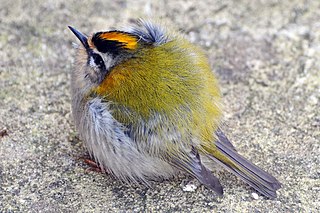
The common firecrest, also known as the firecrest, is a very small passerine bird in the kinglet family. It breeds in most of temperate Europe and northwestern Africa, and is partially migratory, with birds from central Europe wintering to the south and west of their breeding range. Firecrests in the Balearic Islands and north Africa are widely recognised as a separate subspecies, but the population on Madeira, previously also treated as a subspecies, is now treated as a distinct species, the Madeira firecrest, Regulus madeirensis. A fossil ancestor of the firecrest has been identified from a single wing bone.
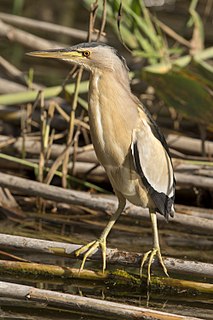
The little bittern or common little bittern is a wading bird in the heron family, Ardeidae. Ixobrychus is from Ancient Greek ixias, a reed-like plant and brukhomai, to bellow, and minutus is Latin for "small".

Micromys is a genus of small rodents in the subfamily Murinae. The genus, which is not closely related to any other murine genus, contains two living species: the widespread Eurasian harvest mouse of much of Europe and Asia; and the more restricted Micromys erythrotis of Vietnam, southern China, and perhaps nearby regions. Fossils of Micromys date back to the Late Miocene and include at least 10 extinct species, which form several lineages.

The giant house spider has been treated as either one species, under the name Eratigena atrica, or as three species, E. atrica, E. duellica and E. saeva. As of April 2020, the three species view was accepted by the World Spider Catalog. They are among the largest spiders of Central and Northern Europe. They were previously placed in the genus Tegenaria. In 2013, they were moved to the new genus Eratigena as the single species Eratigena atrica. In 2018, the three separate species were restored. The bite of these species does not pose a threat to humans or pets, and they are generally reluctant to bite, preferring instead to hide or escape.
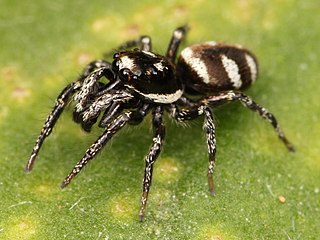
The zebra spider is a common jumping spider of the Northern Hemisphere. Like other jumping spiders it does not build a web. It has a particularly large pair of forward facing eyes that help it to locate and stalk its prey before pouncing on it. Their common name refers to their vivid black-and-white colouration, whilst their scientific name derives from Salticus from the Latin for “dancing”, in reference to their agility, and the Greek scenicus, translating to “theatrical” or “of a decorative place,” in reference to the flashy, zebra-like coloration of the species.

Tegenaria parietina is a rather rare spider in Europe, with a distribution also including Northern Africa to Central Asia and Sri Lanka, and from the West Indies to Uruguay and Argentina, where it may be introduced. In the UK it is sometimes known as the cardinal spider because of the legend that Cardinal Wolsey was terrified by this species at Hampton Court, or, conversely, because he regarded them as lucky and forbade anyone to harm them. In 2013, Tegenaria taprobanica was included in this species.
This is a list of the known wild biota of the Isle of Man.
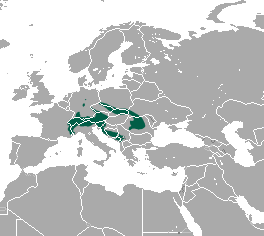
The alpine shrew is a species of mammal in the family Soricidae. It is found in the alpine meadows and coniferous forests of Southern European mountain ranges: the Alps, the Pyrenees, the Carpathian Mountains and the Balkans.

Titanoeca quadriguttata is a species of spider in the family Titanoecidae. It is widespread in Europe, though absent from Great Britain, and is found in Austria, Belgium, Bulgaria, Corsica, Croatia, Czech Republic, France, Germany, Greece, Hungary, Italy, Liechtenstein, Moldova, Russia, Slovakia, Spain, Switzerland, the Netherlands, Ukraine.

Agalenatea redii is a species of 'orbweavers' belonging to the family Araneidae subfamily Araneinae.

Attulus saltator is a species of jumping spider, from the Sitticinae subfamily. It was first described by Frederick Octavius Pickard-Cambridge in 1868 and has a Palearctic distribution, including Great Britain.

Attulus inexpectus is a species of spider from family Salticidae, found in from Europe to central Asia. It was previously misidentified as Attulus rupicola.

Neriene montana is a species of spider belonging to the family Linyphiidae. With a holarctic distribution, it is found throughout northern Europe.

Scotophaeus blackwalli, also known as the mouse spider, is a species of spider belonging to the family Gnaphosidae.
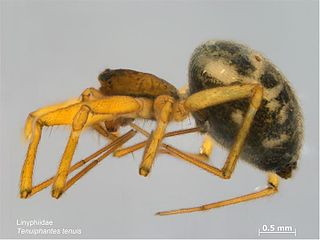
Tenuiphantes tenuis is a species of spider belonging to the family Linyphiidae. Its native distribution is reported as Europe, Macaronesia, Northern Africa, Turkey, Caucasus, Central Asia. The species was introduced to USA, Chile, Argentina and New Zealand from Europe where it is found throughout.

Dictyna arundinacea is a species of spider belonging to the family Dictynidae. It has a holarctic distribution; It is found throughout Britain and northern Europe.
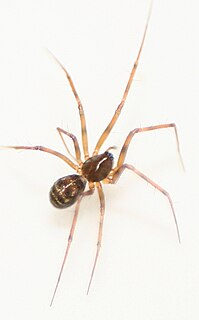
Lepthyphantes leprosus is a species of sheetweb spider in the family Linyphiidae. It is found in North America, a range from Europe to eastern Russia, and has been introduced into Chile.


















